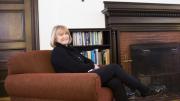The Z closet in Houghton Library is called that because Z is not used in the accession codes for the ordinary run of items in the collection: rare books and manuscripts. The closet instead contains such treasures as T.S. Eliot’s straw panama hat, John Ruskin’s eyepiece, Charles Dickens’s walking cane, locks of various writers’ hair, a group of pencils made by Henry David Thoreau’s father, and a brace of pistols said to have come from George Washington’s headquarters. But unlike Parson Weems’s youthful George with his hatchet, provenances can tell lies.
Collector William B. Osgood Field had a fancy for the works of Edward Lear and Rudyard Kipling, and was a major donor of them to Houghton. He gave the pistols, too, in 1944, says assistant curator of modern books and manuscripts Peter X. Accardo, with a drawing of them that bore the autograph inscription, “Sketch of Washington’s Headquarters Pistols. J.T.” The “J.T.” ostensibly stood for John Trumbull, A.B. 1773, the painter of Revolutionary War scenes who had briefly served as Washington’s aide-de-camp. 
Field bought the pistols and drawing from a dealer who got them at an auction in New York in 1896. The auction featured “the Trumbull revolutionary gallery,” a large group purportedly of pictures done by him and mementos of Washington collected by him. The catalog described the flintlocks thus: “Pair long Pistols, grooved barrels, C. Purcell maker, brass mountings, G.W. engraved on stock, 1776 at side. 22 in. Pair Washington’s Headquarters Pistols. J.T.”
 |
The genuineness of the artworks has been cast into fatal doubt in studies by John Hill Morgan (1941) and Theodore Sizer (1967). If the drawing of the pistols is not what it pretends to be, what of the pistols themselves?
Gretchen M. Goodell, an assistant curator at George Washington’s Mount Vernon, says she doubts the pistols belonged to the general and notes, “We do not often see Washington’s initials inscribed on actual Washington pieces. He usually chose to use his signature griffin crest. When we see ‘G.W.’ it makes us suspicious.”
“The pistols are of a style that was available during the American Revolutionary War,” says Philip Mead, Ph.D. candidate and Artemas Ward fellow in Harvard’s history department. “Their quality, however, is likely too poor to have properly suited Washington as commander in chief. Possibly, the term ‘headquarters pistols’ refers to use by his Life Guards. Some extant swords traditionally associated with the guards have ‘G.W.’ engraved on their blades.”
Imitation being the sincerest form of flattery, a bogus provenance may be seen as evidence of the great esteem in which the father of his country has long been held.





